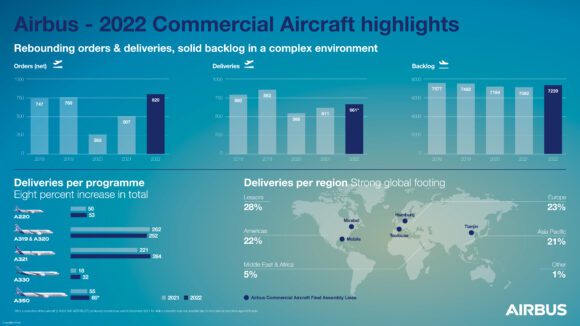
Airbus Tianjin
In a year plagued by supply chain disruptions, Airbus delivered 661 aircraft, some sixty short of the original target. The European airframer won 820 net orders but had to endure 258 cancelations too, some of them anticipated. For 2023, Airbus is positive about the market outlook but cautious about the supply chain, it said today during its 2022 orders and deliveries update. Airbus happy with orders despite ‘anticipated’ cancelations.
The 661 deliveries are thirteen below AirInsight’s estimate of December 31, but then they include some that we missed, like an A220-300 to Iraqi Airways on December 30. Airbus’ original target for 2022 was 720 deliveries, but this number went out of the window as the supply chain was unable to keep up with the pace. Especially engine suppliers struggled to produce enough parts, due to staff shortages. Airbus revised its guidance to 700 in July but said in December that even that wasn’t realistic.
That the deliveries hit 661 doesn’t mean that Airbus will now add the ‘missing’ forty to the 2023 guidance, said CEO Guillaume Faury. “We are still confronted with supply chain issues. Those planes are not planes that have been produced and are waiting to be delivered. We are limited by supply, so there is no indication in 2023, coming from these ‘planes missing’ that we can add them. The supply chain will remain constrained. The headwind of the complexity of the supply chain remains in 2023 and it will remain challenging to ramp up in this environment.”
Yet, Airbus will continue to gradually ramp up the production of the A220, A320neo family, and A350. Rate 65 per month remains the target for the A320neo family next year, with rate 75 still foreseen by the middle of this decade, Faury said. “Delivering on our backlog, continuing the ramp-up while protecting our supply chain is our key priority.”
Deliveries
Taking a closer look at the 661 deliveries, 264 were A321neo’s, which confirms that Airbus’s best-selling type is now firmly produced at higher numbers than its smaller sister. ‘Only’ 246 A320neo’s left Hamburg, Toulouse, Mobile, and Tianjin, while six A319neo’s were delivered. In total 516 A320neo family aircraft were delivered, up from 483 in 2021.
A220 deliveries totaled 53 versus 50 in 2021, of which 47 -300s and six -100s. Faury confessed that this was lower than expected, but again, the supply chain was unable to keep up with ambitions.
A330 deliveries saw 32 aircraft leaving the factory compared to eighteen in the previous year. They include five -200s, four -300s (most of them military of tanker aircraft), just three -800s, and twenty -900s.
Of the A350, Airbus delivered 62 aircraft versus 55 in 2021: 52 -900s and ten -1000s. Actually, two -900s have to be excluded, because they were for Aeroflot. Following the war in Ukraine and sanctions on Russia, deliveries to the airline were impossible.
Orders
Then the orders. The 820 net orders compare favorably against 507 in 2021. The A321neo won 425 net orders, the A320neo 330, the A319neo fifteen, the A220 105, and the A350F 24. But after cancelations, the A330-900 ended with -65 net orders, the A350-900 at -3, and the -1000 at -11. Overall, the number of cancelations was almost identical to 2021: 258 versus 264.
Chief Commercial Officer Christian Scherer said that a few of these cancelations was largely anticipated, indirectly referring to the AirAsia X order for 63 A330-900s that was in doubt for a long time. Without any reference, the termination of the Qatar Airways order for fifty A321neo’s and nineteen remaining A350-1000s in the backlog was also inevitable, given the tense relations between the two. In all, the A330-900 saw 84 cancelations, the A321neo 76, -40 A320neo’s, -23 A350-1000s, -19 A220-300s, -11 A350-900s, -3 A220-100s, and -2 A319neo’s.
But Scherer’s main message was that 2022 was a strong year commercially, which is confirmed by big orders from China’s Big Three for over 300 aircraft, eighty from BOC Aviation, forty from Xiamen Airlines, 59 from IAG, 56 from easyJet, 52 from Qantas, just to name the biggest ones. Despite economical and geopolitical uncertainties, demand for air travel remains strong and this is reflected in the demand for aircraft. Airbus’ backlog ended with 7.239 aircraft, up from 7.082 a year ago.
“We witnessed quite a few customers that were placing strategic and quite significant new orders in all segments that we are serving. We had over 300 orders more in 2022 than in 2021 and a net book to bill significantly above 1 in terms of aircraft units. This underpins the strength of our product range in this recovering market.” Demand for single-aisle aircraft remains strong.
Widebody recovery
Even at -79 net orders for the widebodies, Scherer said: “The market is there and the recovery is real and is now also perceptible in the widebody segment. (…) Even though the total number of campaigns isn’t huge, I want to point out that there were thirteen passenger widebody deals globally, of which Airbus won eight. Not just with existing customers but also with new customers. This is a clear signal ahead of the market recovery.” The sales chief anticipates more announcements, “so watch this space.”
Scherer is also pleased with the response of the market for the A350F, with 24 orders from five customers: “That is an inspiring result in the first year in which we marketed this aircraft.” More campaigns are underway.
Asked about the backlog, Scherer said: “We could be selling a lot more airplanes if we had more capacity. Between the 320 and 220 there is a thousand airplanes booked this year, which shows that it isn’t really a deterrent to many people to wait a few more years for the better product. (…) Yes, the A320neo is sold out until 2029, but we have a good backlog of single-aisle aircraft with our leasing community. There are availabilities in the medium term with them before we could serve them.”
Views: 5




